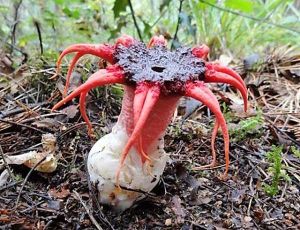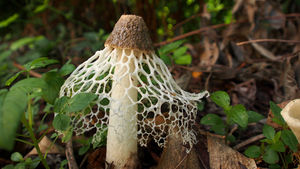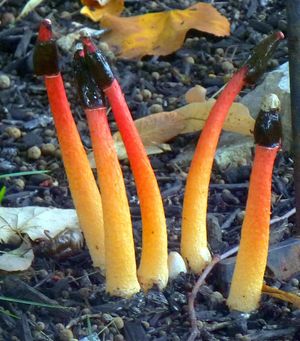Stinkhorns

Description

Stinkhorns make up the Phallaceae mushroom family and are easily recognizable by their unique shape and pungent smell [2]. Stinkhorns are characterized by their phallic appearances, hence the reference to the term Phallus in their taxonomic group name [5]. Some species will grow appendages that give them an octopus-like or lacey skirt appearance [2]. It is often stated that you will smell a stinkhorn before you actually identify them due to their odor which resembles rotting carrion or dung [5]. Stinkhorn stalks range in color from white, beige and olive to bright reds and oranges [2]. This species of fungus attracts numerous soil invertebrates with their scent, such as blowflies, beetles and slugs [5].
Habitat and Range
Stinkhorns grow naturally in North America and are most diverse in tropical or subtropical regions [4]. They grow particularly well in Florida and the Gulf Coast region of America, but it is relatively unknown which species of stinkhorn are native or introduced to the region, along with the rest of North America [5]. These fungi can become easily established in temperate regions such as Western New York after introduction [5].

Stinkhorns are often introduced via human activity, such as the transportation of soil, sod, trees and other organic materials that contain microscopic hyphae from other regions of the country [4]. Stinkhorn fungi can exist in any environment that provides organic matter as this is their food source [6]. They can appear in forests, gardens, lawns and even on bare soils [2]. However, stinkhorns will commonly form on the wood chips, leaf litter, and other decaying matter they feed upon [5].
Species of Stinkhorns
The stinkhorn species Phallus impudicus, appropriately nicknamed the "common stinkhorn", is the most naturally occurring of the species. Characterized by a long stalk of up to 25 centimeters, and an off-white cap coated in yellow spores and a dark green gleba [7]. The common stinkhorn will fruit in the autumnal months, while eggs will lie dormant in the winter and spring months [7]. This species tends to inhabit temperate forests containing deciduous trees. The species Phallus hadriani, known as the "dune stinkhorn" or the "sand stinkhorn" is different from the common stinkhorn as it may have a pink or purple color in the stem and smell of a different odor, often described as a rotting meat smell [5]. Both, however, have a conical cap an olive green colored gleba. The "dog stinkhorn", Mutinus caninus, is known for its pink and yellow stalk, and bright orange conical cap [8]. Much brighter than the previously mentioned species, it is easier to distinguish, but the gleba is still the same dark green color. As of 2008 scientists have found and recorded 21 separate genera and 77 different species of stinkhorns.
Growth and Toxicology
Stinkhorns begin their life cycle as small egg-like structures that appear on the surface of the soil or mulch [5]. These eggs attach themselves to the fruiting substrate via rhizomorphs, which are delicate white strands of fungal tissue [5]. Within as little as a few minutes or hours, a stalk will emerge from the egg structure and stretch upwards [3]. The stinkhorn stalk is topped with a pungent, slimy spore mass known as the gleba [3]. The gleba attracts a series of invertebrates with its stinky odor that feed on the spore mass and then transport the spores elsewhere [5]. After the feeding invertebrate leaves the stinkhorn, its spores are spread through excrement or are transported by sticking to the invertebrate via the slime of the gleba until they stick elsewhere in the environment [5]. From here, the spores will establish a new crop of stinkhorn fungus if the environment is suitable, continuing their short-lived life cycle. While stinkhorns have a somewhat unsettling appearance and odor, they are not poisonous with a few exceptions [5]. In fact, many stinkhorns are edible in the egg state and are used for culinary purposes, however correct identification of the spores is essential to avoid potential calamity [5].
Ecosystem Function
Stinkhorns play an essential role in their ecosystems as they are decomposers, so they aid in the breakdown of organic litter that would otherwise sit on the soil surface and potentially stifle other species [5]. They are also an important food source for many soil invertebrates [5]. In some cases, stinkhorns have even provided alternate breeding substrates for fly species such as Drosophila when normal breeding habitat is not available, allowing them to prolong population survival [1]. However, interactions between stinkhorns and invertebrates are known to be beneficial, but are poorly studied so not much is known about their ecological role besides the basics. Stinkhorns are also known to contribute in nutrient cycling, which is important to the health of an ecosystem [7].
References
[1] Jadhav, R., S. Tiwari, R. Avchar, M. Groenewald, and A. 2020 Baghela. (n.d.). Suhomyces drosophilae sp. nov., isolated from Drosophila flies feeding on a stinkhorn mushroom. International Journal of Systematic and Evolutionary Microbiology 70:4908–4913.
[2] P, V. and ian. (2016). Stinkhorns. https://hort.extension.wisc.edu/articles/stinkhorns/.
[3] Phallaceae. (n.d.). . https://plantbiology.natsci.msu.edu/mushrooms/phallaceae/.
[4] Phallaceae: The Stinkhorns (MushroomExpert.Com). (2011).</ref> https://www.mushroomexpert.com/phallaceae.html.
[5] Phillips, E., J. L. Gillett-Kaufman, and M. E. Smith. 2018. Stinkhorn Mushrooms (Agaricomycetes: Phallales: Phallaceae). EDIS 2018.
[6] Stinkhorns. (2005). http://hyg.ipm.illinois.edu/pastpest/200519b.html.
[7] Woodland Trust. (n.d.). Stinkhorn. https://www.woodlandtrust.org.uk/trees-woods-and-wildlife/fungi-and-lichens/stinkhorn/.
[8] Gretchen Voyle, M. S. U. E. 2021, March 9. Stinky Dog Stinkhorn Mushrooms. https://www.canr.msu.edu/news/stinky_dog_stinkhorn_mushrooms.